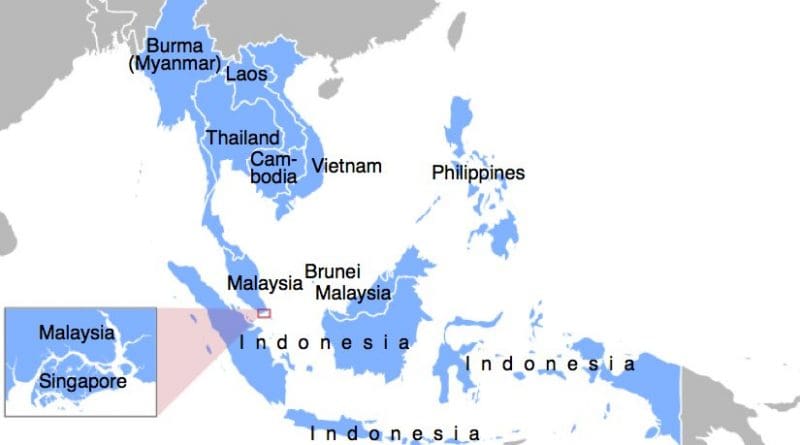By Benjamin Tze Ern Ho*
 Following the publication of the ASEAN Outlook on the Indo-Pacific (AOIP) earlier this year, Chinese observers have trained their focus on what the AOIP means for Beijing’s relations with Southeast Asia. Come 2020, it is likely that China would demand greater clarity concerning the practical “deliverables” of the AOIP.
Following the publication of the ASEAN Outlook on the Indo-Pacific (AOIP) earlier this year, Chinese observers have trained their focus on what the AOIP means for Beijing’s relations with Southeast Asia. Come 2020, it is likely that China would demand greater clarity concerning the practical “deliverables” of the AOIP.
During the 34th ASEAN Ministerial Meeting in Bangkok in June 2019, ASEAN foreign ministers agreed to the publication of what they referred to as the ASEAN Outlook on the Indo-Pacific (AOIP). This effectively states the regional grouping’s position on the Indo-Pacific while ensuring that it was seen as not taking sides in geopolitical competition.
Up till then, much of Chinese analysis concerning the Indo-Pacific strategy was focused on the members of the Quad (US, Japan, Australia and India) and how the Indo-Pacific concept reflected the geopolitical calculations of the four countries.
ASEAN’s Voice on the Indo-Pacific
Following the rollout of the AOIP, China was relatively guarded in its assessment and refrained from stating an official position regarding its support or concerns towards the document.
Nevertheless there was a tacit acknowledgement among Chinese scholars and policymakers that the AOIP – at the very least – reflected ASEAN member states’ own initiative to advance regional security developments on ASEAN’s own terms rather than having to acquiesce to terms imposed by external powers.
The fact that ASEAN was able to manoeuvre adroitly through the currents of geopolitical competition to forge a common position was seen as a mark of success. ASEAN’s seeming lack of clarity in forging a common position regarding the Indo-Pacific was certainly not Beijing’s preference.
The fact that much of the language the AOIP was couched in also coincided with China’s general preference towards regional and international order meant that there was also little for Beijing to complain about.
Challenges Ahead: Chinese Perspectives
Notwithstanding the success of the AOIP in allowing ASEAN breathing space to engage the major powers, there are several challenges ahead. My research in China and interviews with Chinese scholars have led to the following points observations:
Firstly, there was a concern in China that given ongoing Sino-American tensions, the AOIP could inevitably be subsumed under America’s own Indo-Pacific vision thus diluting ASEAN’s position and perspective. It was also observed that in practical matters, major powers would inadvertently have a greater share and say and thus were unlikely to concede their geopolitical priorities to ASEAN’s own.
In other words, ASEAN was seen as having limited influence over the major powers and would not find it easy to convince external powers to abide by the rules of its playbook.
Secondly, it was observed that ASEAN’s success in playing a central role in regional cooperation was only possible because none of the major powers involved in the region could obtain the unanimous support and buy-in of other major powers for their respective regional mechanisms. Hence external powers were happy to allow ASEAN to facilitate attempts at regional cooperation as this was better than nothing.
Inherent Weaknesses?
However, it was noted that given the AOIP was not aimed at creating new mechanisms nor replacing existing ones, it would likewise be subjected to the weaknesses and limitations of current multilateral arrangements. These include criticisms that ASEAN-led forums were only “talk-shops” and were unable to resolve conflicts or provide practical solutions to regional problems.
Furthermore, it was highlighted that given the ASEAN-led East Asia Summit (EAS) at present was focused on economic issues while the Indo-Pacific strategy was primarily a security issue, there was a need for ASEAN to consider expanding the remit of the EAS to account for the Indo-Pacific. An expanded EAS however could be less effective (due to increased participation) and would make cooperation more difficult.
Finally, it was also highlighted that there was a disparity in the domestic considerations of ASEAN member states and that their respective relations with the major powers also differed greatly. Notwithstanding the AOIP, each of the ten ASEAN countries possessed their respective perspectives and had varying degrees of support towards the AOIP.
Furthermore, for the objectives of the AOIP to be achieved, ASEAN could not do so on its own, but required the support and participation of external powers, thus resulting in having to take into account the complexities of major power competition.
What Next for AOIP?
With these considerations in mind, one can conclude that China – at present – would be unlikely to commit to voicing any political support for the AOIP. Instead what Beijing is more interested in would be how this would translate into greater practical cooperation between ASEAN countries and itself.
For instance, defence initiatives such as the ASEAN-China Maritime Exercise launched last year were seen by China as visible examples of cooperation that reflected the goodwill between the countries involved. Moving forward, it is likely that China would want to push for greater institutionalisation of ties between its relevant stakeholders and those of ASEAN.
Nevertheless there are concerns that such initiatives may privilege China and lead ASEAN member states towards a Sino-centric multilateral arrangement. Beijing would have to tread cautiously in its courting of ASEAN, so as not to be seen as being coercive in its regional diplomacy.
At the same time, for ASEAN to maintain its centrality and relevance in the regional security architecture, its actions – and not just its words – will be closely scrutinised by both Beijing as well as the other powers.
*Benjamin Tze Ern Ho is a Research Fellow with the China Programme, S. Rajaratnam School of International Studies (RSIS), Nanyang Technological University (NTU), Singapore. He was recently a visiting fellow at the School of International Studies, Jinan University, Guangzhou.
No comments:
Post a Comment